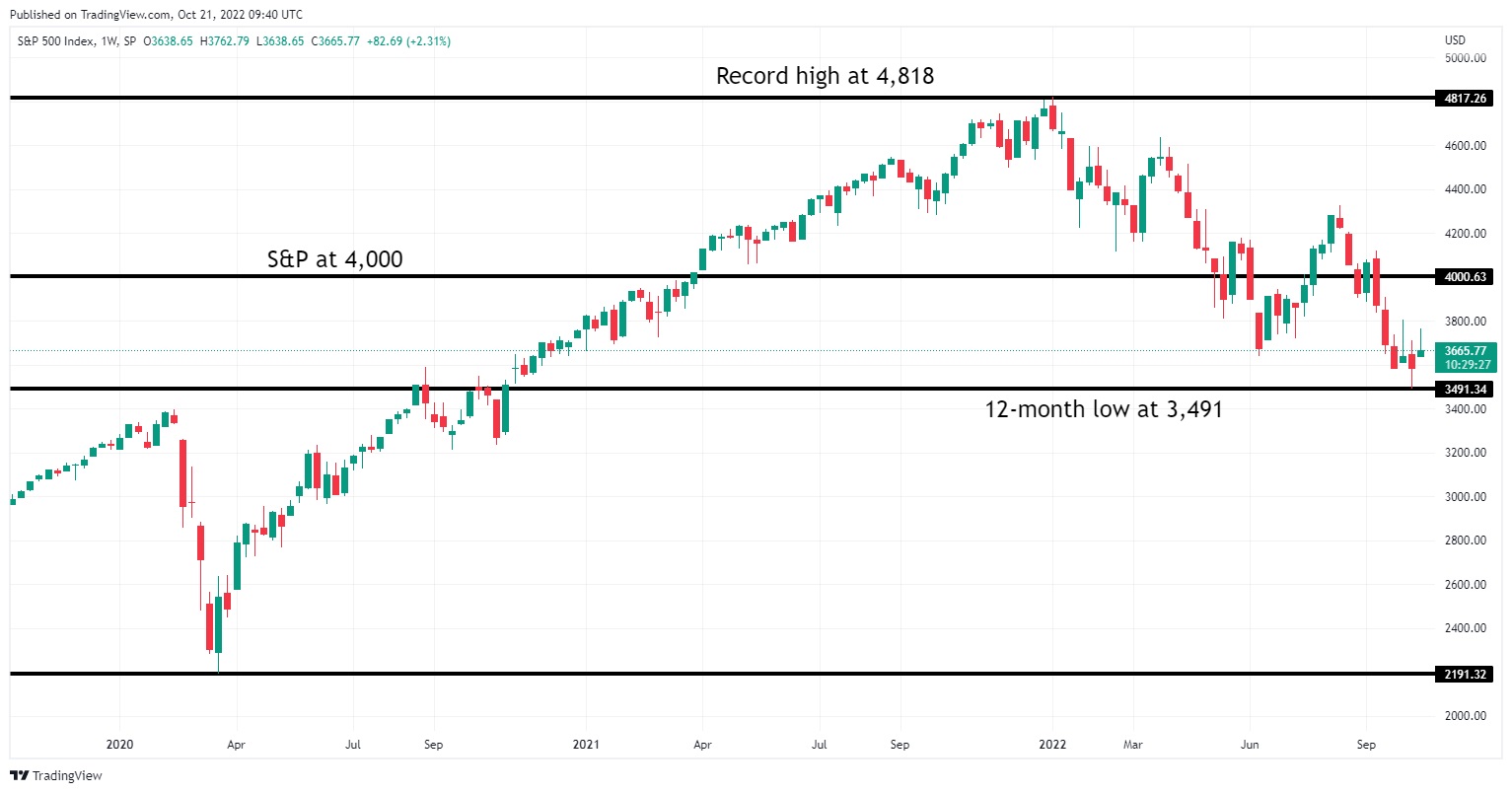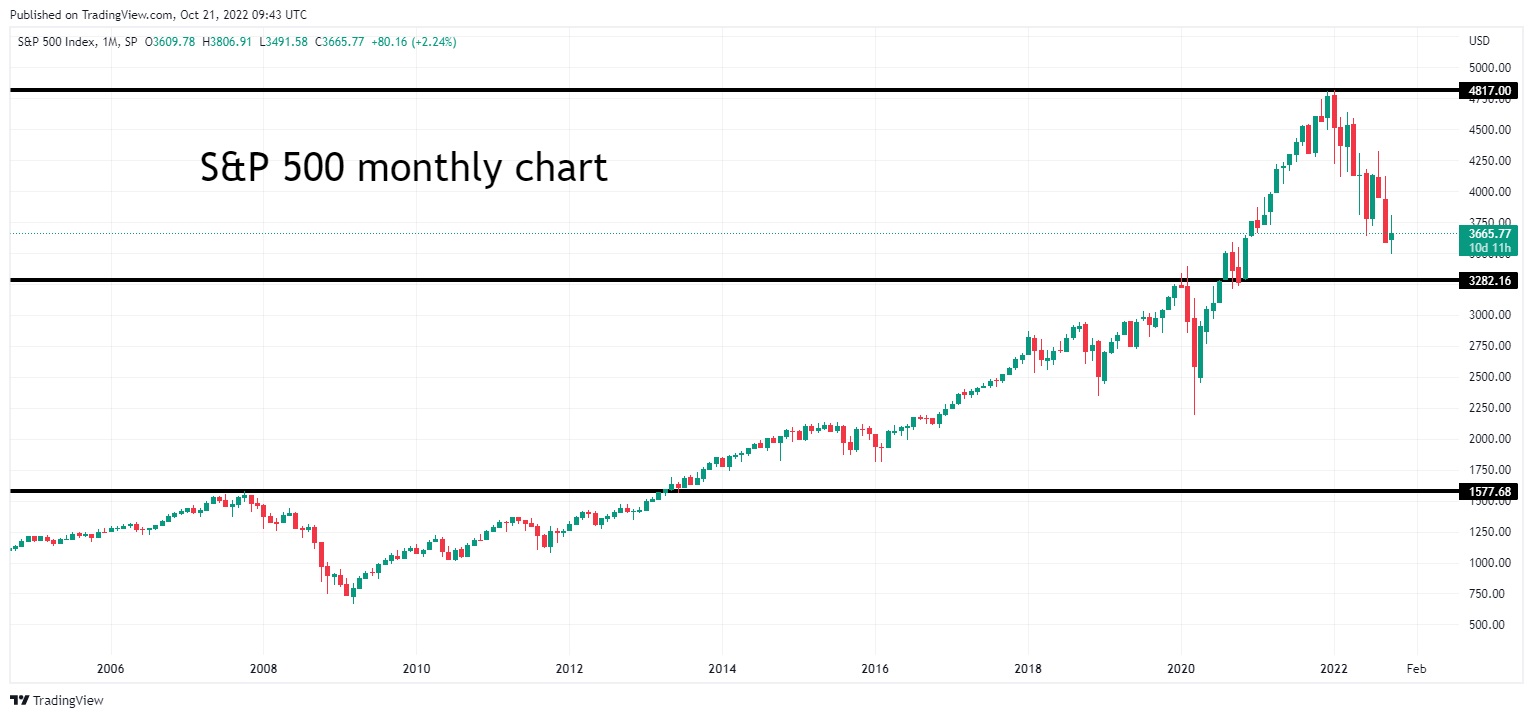Stockwatch: analysing market forecasts and the sudden interest in bonds
21st October 2022 11:33
by Edmond Jackson from interactive investor
With so many catalysts moving share prices right now, analyst Edmond Jackson runs through the possibilities, what might happen in 2023, and why bonds have captured his interest.

Six months ago, I noted Bank of America (BoA) strategists calling 4,000 on the S&P 500 index a “tipping point” - potentially triggering a mass exodus from equities.
When their note was published, the index was around 4,200 and it proceeded to drop to 3,667 by mid-June.
A relief rally was possible, they said, but amid depressed sentiment it would not be much and investors should sell it.
- Learn about: How Bonds & Gilts work | Free regular investing | Buy Bonds
The recent chart indeed shows recovery to over 4,300 by mid-August, then a drop below 3,600 as of early October.

Past performance is not a guide to future performance.
Yet the current level around 3,665 is only an 8% fall from 4,000. Despite ongoing fears of a US recession, stocks are generally firm in response to third-quarter reporting.
Maybe that partly reflects low expectations ahead of results, or perhaps investors are mindful of how trading may involve taxation of capital gains (hence less to re-invest and compound), and also the dilemma of when to buy back.
US equities may not be your prime focus, but the validity of technical analysis is relevant to stocks anywhere.
A pragmatic view combines charts with fundamentals
I respect how BoA’s call marked quite a turning point, yet arguably the one to sell was in late summer 2021 when growth stocks and small-caps started to wilt on expectations of higher interest rates.
Change in fundamentals has been the catalyst: war in Ukraine has contributed to stagflation just as central banks face a tricky challenge to normalise monetary policy.
In the UK, political instability adds to uncertainties – now of higher taxes, lower public spending and another jump in energy prices from next April.
Unsurprisingly, UK cyclical stocks have resumed falls – for example, continued weakness in housebuilders yesterday, despite the CEO of Vistry Group (LSE:VTY) having spent £5.5 million buying its equity (also in his capacity as chairman of Baker Estates Limited).
In the US, it appears some consumer-facing businesses are doing well, others not.
The Fitch credit-rating agency anticipates a US recession in the second quarter of 2023, quite like 1990-91 after a similar period of rapid monetary tightening in 1989-90. Fitch reckons downside is limited by strong consumer finances, but what extent might they reflect cash hand-outs during Covid lockdowns is unclear, so could be fleeting.
On Wednesday, Goldman Sachs’ CEO entertained the prospect of a US recession next year, although a soft landing is still possible if inflation can be tamed without much economic pain.
Jeff Bezos tweeted in response: “Yep, the probabilities in this economy tell you to batten down the hatches.”
- Four American banks: buy, sell, hold?
- The 100-year decline of the British pound from five to one dollar
- Jeremy Hunt scraps tax cuts: winners and losers
This was followed yesterday by a Conference Board leading economic index decreasing 0.4% to 115.9 in September, having been unchanged in August but otherwise trending downwards this year. The Board’s 10 analytic variables suggest US recession by end-2022 with a further slowing in the first half of 2023.
I would meld technical analysis – the balance of stock buyers and sellers – into such observations to suggest stock market lows are a way off yet. Enough buyers may sit on their hands and there is a risk of reactive selling if earnings start to fall sharply.
As a most sensitive example – a UK small-cap cyclical, geared to housing re-fits – it is notable how lighting specialist Luceco (LSE:LUCE) yesterday saw its price fall 8%, back to its April 2020 level of 67p, after a profits warning.
In September, Luceco had jumped over 40% to 111p but has now re-asserted a downtrend since August 2021.
That was a stark example of a bear market rally, showing also the risk with small-caps, those recent share price losses coming at what might be the early stages of recession with “cheap” ratings – Luceco is supposedly on a forward price/earnings (PE) ratio of 5x and yields over 7%.
How relevant is the 200-day moving average for the S&P 500?
Morgan Stanley strategists argue US equities are ripe for a near-term rally, given a 25% slide in the index this year leaves it testing a serious floor of support:

Past performance is not a guide to future performance.
Quite whether “testing support” is sufficient to justify a rally is unclear, and what if stocks were to drop below this critical level – is that not another chart tipping point?
I break rank with such a glass-half-full, or empty, view of the market, and also question a rear-mirror view.
Monetary policy is undergoing a sea-change, from loose after the 2008 financial crisis (which persisted too long) to ultra-loose during Covid lockdowns – and is now tightening against inflation.
Yet Michael Wilson, Morgan’s key strategist, thinks there is near-term potential for a return to 4,150, in line with bear market rallies this year and before.
He believes inflation has already peaked and could fall rapidly next year, and that it usually takes a full-blown recession for the S&P 500 to fall below its 200-day moving average.
Yet he still expects “an acute and material earnings deceleration over the next 12 months”.
I would mind how the UK’s political chaos raises the risk premium for domestic equities, and why a bellwether such as BT Group (LSE:BT.A) fell 3% yesterday before Truss resigned.
Wilson retains an overall negative long-term stance on US equities and expects the S&P 500 to bottom out around 3,000 to 3,200 – implying over 15% downside from here.
How significant is rising UK financial distress?
Insolvency specialist Begbies Traynor Group (LSE:BEG) has cited a 25% like-for-like increase in the number of UK businesses in critical financial distress during the third quarter.
Bars and restaurants, also general retailers, drove this rise – up 48% and 72% respectively – followed by leisure (quite easy for consumers to cut spending here) and media (reliant on advertising).
The new chancellor’s U-turn on freezing alcohol duty has caused dismay for a hospitality sector struggling to cap soaring costs.
Nearly 610,000 UK companies are said to be in significant financial distress, an 8% year-on-year increase and 4% quarterly.
- Bond Watch: has Jeremy Hunt tamed the ‘bond vigilantes’?
- Benstead on Bonds: historic gilt collapse is a classic ‘blood on the streets’ moment
I do not necessarily flinch. This more likely represents private rather than publicly-listed firms, some of which have been propped up by ultra-low interest rates for too long.
A free marketer would welcome a rise in distress, to shutter “zombies” and deploy resources elsewhere. Such economic restructuring would, however, add to general strain.
Ric Traynor, executive chairman of Begbies, says: “This latest data clearly shows many UK businesses are struggling...Unfortunately, things are only likely to get worse, especially while we have the conflict in Ukraine...With consumer confidence where it is, it feels like we are heading towards a bleak winter and 2023 and, after two years of extensive financial support, the government has little left in reserve to help businesses ride out this storm.”
Not to lose sight that pessimism is a friend to equity buyers, I just would prefer to see this downturn get better reflected in listed company numbers and guidance.
Many say they are coping but I am steeled for lower revenues and higher costs to impact profits.
Hurdle presently looks lower for bonds than equities
Furthermore, PE multiples may be affected by UK inflation at around 10% - possibly requiring 6% interest rates next year unless recession cuts inflation.
Investors may therefore be tempted to shift portfolio balances towards bonds, especially now that bond prices have fallen steeply and yields risen. Income may also become more of a priority than capital growth.
Bond prices could twitch positively before equities, given they need only expectations of a change in monetary policy, whereas equities may require evidence of sustainable prospects.
Perhaps the crux is whether a short sharp recession ensues, or a prolonged period of stagflation. Yes, equities statistically offer superior long-term returns, but now may be opportune for having some exposure to bonds.
Edmond Jackson is a freelance contributor and not a direct employee of interactive investor.
These articles are provided for information purposes only. Occasionally, an opinion about whether to buy or sell a specific investment may be provided by third parties. The content is not intended to be a personal recommendation to buy or sell any financial instrument or product, or to adopt any investment strategy as it is not provided based on an assessment of your investing knowledge and experience, your financial situation or your investment objectives. The value of your investments, and the income derived from them, may go down as well as up. You may not get back all the money that you invest. The investments referred to in this article may not be suitable for all investors, and if in doubt, an investor should seek advice from a qualified investment adviser.
Full performance can be found on the company or index summary page on the interactive investor website. Simply click on the company's or index name highlighted in the article.
Disclosure
We use a combination of fundamental and technical analysis in forming our view as to the valuation and prospects of an investment. Where relevant we have set out those particular matters we think are important in the above article, but further detail can be found here.
Please note that our article on this investment should not be considered to be a regular publication.
Details of all recommendations issued by ii during the previous 12-month period can be found here.
ii adheres to a strict code of conduct. Contributors may hold shares or have other interests in companies included in these portfolios, which could create a conflict of interests. Contributors intending to write about any financial instruments in which they have an interest are required to disclose such interest to ii and in the article itself. ii will at all times consider whether such interest impairs the objectivity of the recommendation.
In addition, individuals involved in the production of investment articles are subject to a personal account dealing restriction, which prevents them from placing a transaction in the specified instrument(s) for a period before and for five working days after such publication. This is to avoid personal interests conflicting with the interests of the recipients of those investment articles.